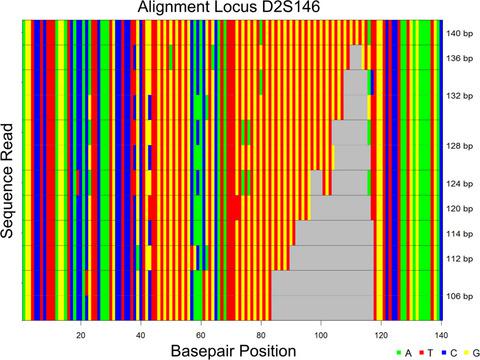当前位置:
X-MOL 学术
›
Ecol. Evol.
›
论文详情
Our official English website, www.x-mol.net, welcomes your
feedback! (Note: you will need to create a separate account there.)
A refined panel of 42 microsatellite loci to universally genotype catarrhine primates
Ecology and Evolution ( IF 2.3 ) Pub Date : 2020-12-13 , DOI: 10.1002/ece3.7069 Franziska Trede 1, 2 , Niels Kil 2, 3, 4, 5 , James Stranks 2, 3, 4, 5 , Andrew Jesse Connell 6 , Julia Fischer 1, 4, 7 , Julia Ostner 3, 4, 5 , Oliver Schülke 3, 4, 5 , Dietmar Zinner 1, 4, 7 , Christian Roos 2, 8
中文翻译:

42 个微卫星位点的精细面板可对卡他灵长类动物进行通用基因分型
更新日期:2021-01-08
Ecology and Evolution ( IF 2.3 ) Pub Date : 2020-12-13 , DOI: 10.1002/ece3.7069 Franziska Trede 1, 2 , Niels Kil 2, 3, 4, 5 , James Stranks 2, 3, 4, 5 , Andrew Jesse Connell 6 , Julia Fischer 1, 4, 7 , Julia Ostner 3, 4, 5 , Oliver Schülke 3, 4, 5 , Dietmar Zinner 1, 4, 7 , Christian Roos 2, 8
Affiliation

|
- Microsatellite genotyping is an important genetic method for a number of research questions in biology. Given that the traditional fragment length analysis using polyacrylamide gel or capillary electrophoresis has several drawbacks, microsatellite genotyping‐by‐sequencing (GBS) has arisen as a promising alternative. Although GBS mitigates many of the problems of fragment length analysis, issues with allelic dropout and null alleles often remain due to mismatches in primer binding sites and unnecessarily long PCR products. This is also true for GBS in catarrhine primates where cross‐species amplification of loci (often human derived) is common.
- We therefore redesigned primers for 45 microsatellite loci based on 17 available catarrhine reference genomes. Next, we tested them in singleplex and different multiplex settings in a panel of species representing all major lineages of Catarrhini and further validated them in wild Guinea baboons (Papio papio) using fecal samples.
- The final panel of 42 microsatellite loci can efficiently be amplified with primers distributed into three amplification pools.
- With our microsatellite panel, we provide a tool to universally genotype catarrhine primates via GBS from different sample sources in a cost‐ and time‐efficient way, with higher resolution, and comparability among laboratories and species.
中文翻译:

42 个微卫星位点的精细面板可对卡他灵长类动物进行通用基因分型
微卫星基因分型是解决生物学中许多研究问题的重要遗传方法。鉴于使用聚丙烯酰胺凝胶或毛细管电泳的传统片段长度分析有几个缺点,微卫星测序基因分型(GBS)已成为一种有前途的替代方案。尽管 GBS 缓解了片段长度分析的许多问题,但由于引物结合位点不匹配和不必要的长 PCR 产物,等位基因缺失和无效等位基因的问题通常仍然存在。对于卡他灵长类动物中的 GBS 也是如此,其中基因座的跨物种扩增(通常是人类衍生的)很常见。
因此,我们根据 17 个可用的卡他碱参考基因组重新设计了 45 个微卫星位点的引物。接下来,我们在一组代表卡他尼主要谱系的物种中进行单重和不同多重设置中的测试,并使用粪便样本在野生几内亚狒狒( Papio papio )中进一步验证它们。
最终的 42 个微卫星位点组可以使用分布在三个扩增池中的引物进行有效扩增。
借助我们的微卫星面板,我们提供了一种工具,可以通过 GBS 对来自不同样本来源的卡他灵长类动物进行通用基因分型,以经济高效的方式进行,并且具有更高的分辨率以及实验室和物种之间的可比性。


















































 京公网安备 11010802027423号
京公网安备 11010802027423号